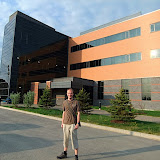You can see my thoughts and feelings about the day on my personal blog entitled ‘2km’ at http://davidault.blogspot.com but here I want to mention some of the science behind the day too and pay homage to the feat of engineering and pioneering skill that I witnessed. It must also be mentioned that work is underway to quadruple the lab’s working space; this too is an eye-opening operation that deserves trumpeting.
 |
| SNOLAB |
Laboratories, especially those trying to spot minute flashes of light from almost massless particles on their rare interactions with matter, have to be absolutely pristine places. SNOLAB is no different; the air inside the ‘clean’ area of the lab is the same quality, contaminants-wise, as a hospital operating theatre. To accomplish this, large air filters are installed to trap particulates in the atmosphere inside the clean areas. SNOLAB however has another major obstacle to contend with in this regard; it is 6800ft down a working mine, and a similar distance along a very dirty, muddy drift before even reaching the lab.
Everyone must go through the strict protocols of showering before entry into the lab. Your mine clothes are left at the entrance and you are given a set of overalls and boots in which to walk around the clean area, along with a hair band, hard-hat and safety goggles. Blue sticky plastic is laid down at each doorway to trap any dust that may have made its way onto your boots. But why is something as simple as dust so much of a problem in any case? The answer is that down in the rock the dust contains more radioactive particles that, if found in the wrong place, could cause false detections in the experiments.
The original SNO experiment was decommissioned in 2007, but since then the work has moved forward to build on the successes of that original experiment. SNO+ is going to take the original SNO and put a liquid scintillator in place of the heavy water, a task that will require the inversion of the tethering filaments (due to liquid scintillator being lighter than the water around it, heavy water being unsurprisingly the opposite) – again no mean feat.
I should add, at this point, another interesting point of engineering for the company; the cage that ferries the workers down the mine is small, and is designed to fit 44 men in rows of four shoulder-to-shoulder. It is in this space that all equipment must fit or, if necessary, hang beneath the cage – in this instance though the item must be able to be pulled through the opening at operating level. Every piece of equipment must also be cleaned meticulously once it gets into the clean area, or arrive bagged up.
I cannot imagine how many trips were needed to get all the equipment down the mines, nor how many continue to happen each day as the new work is taking place. There are new experiments to search for dark matter particles – PICASSO and DEAP-3600 – and one for a supernova early-warning system called HALO. Many other scientific groups want to use the facility, shielded as it is from cosmic rays by 2km of rock, to collect data, and this is part of the reason behind the expansion.
There will be more information about the SNOLAB and its history from my guide, Dr Fraser Duncan on a future episode of the Jodcast. Suffice it to say, this was a tour of a facility that I will never forget, a chance to see building work happening in challenging surroundings and all thanks to the science communication community. To those of you who read this blog, thank you ever so much, and to Samatha Kuula and Fraser Duncan, my guides, and to Paul Arkilander, my host and chauffeur for the day, my deepest gratitude.



No comments:
Post a Comment